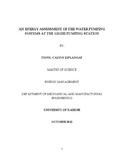| dc.description.abstract | The current energy situation in the country is characterized by high demand for energy
and escalating costs. As a result, peak electricity demand has risen to 1)07 megawatts
(MW)against an effective supply of 1)35 MW, leaving a reserve margin of 4%against
the desired 15%necessary for grid system stability [1]. Since energy demand is growing
faster than the energy supply growth, it has become necessary for the country to
manage its existing energy supply efficiently in order to prevent the imminent collapse
of the country's electric supply system.
Municipal water pumping is an energy-intensive process. The cost per unit of electricity
has continued to rise at the Nairobi City Water and Sewerage Company's Gigiri
pumping station, with an increase of 54% from May 2010 to February 2012. The
pumping station had a maximum electricity demand range of 1,314kVA and 1,664kVA
during the period 2010-2011and 2011-2012respectively.
The Gigiri pumping station operates on a 24 hour schedule. There are four pumping
units each comprising of an electric motor connected to a centrifugal pump, a capacitor,
surge vessel, piping system and flow control accessories. The only source of energy at
the pumping station is electricity.
The pumping station's average monthly electricity consumption was 882,753kWh in
the period 2010-2011and 847,894kWh in the period 2011-2012with observed specific
energy intensities of 0.667 kWh/m3, and 0.629 kWh/m3, respectively. The pumping
station's average monthly flow discharge was 1,338,533m3 during the period 2010-2011
and 1,348,568m3 during the period 2011-2012.
The pumping station's average system efficiency stood at 49%, with the highest
pumping system efficiency of 70%being attained when pump No.4 was running alone.
The lowest pumping system efficiency of 34%was observed when running the parallel
combination of the pumps No.1 and No.2.
iii
The pump with the highest pump efficiency was No.4 with an efficiency of 74%. The
lowest pump efficiency was recorded in the pump No.1 with an efficiency of 46%.
Areas in the pumping system that were identified for potential energy cost savings
included: Efficient single pump operation in place of inefficient and mismatched
parallel pump operation - with potential annual energy savings of KES4,904,254with
an immediate and at no cost savings benefit, the adjustment of the best efficiency point
(BEP)of the Pump No.1 through an overhaul with potential annual energy savings of
KES7,220,495with a payback period of approximately 1.5 years and recovery of cooling
water losses from the pump bearings with potential annual water and energy cost
savings of KES1,110,798with a payback period of approximately 1 month. | en_US |

